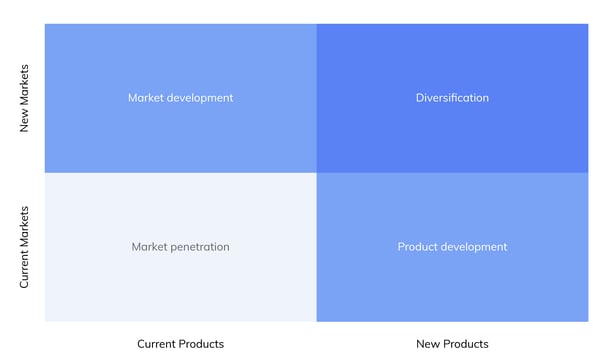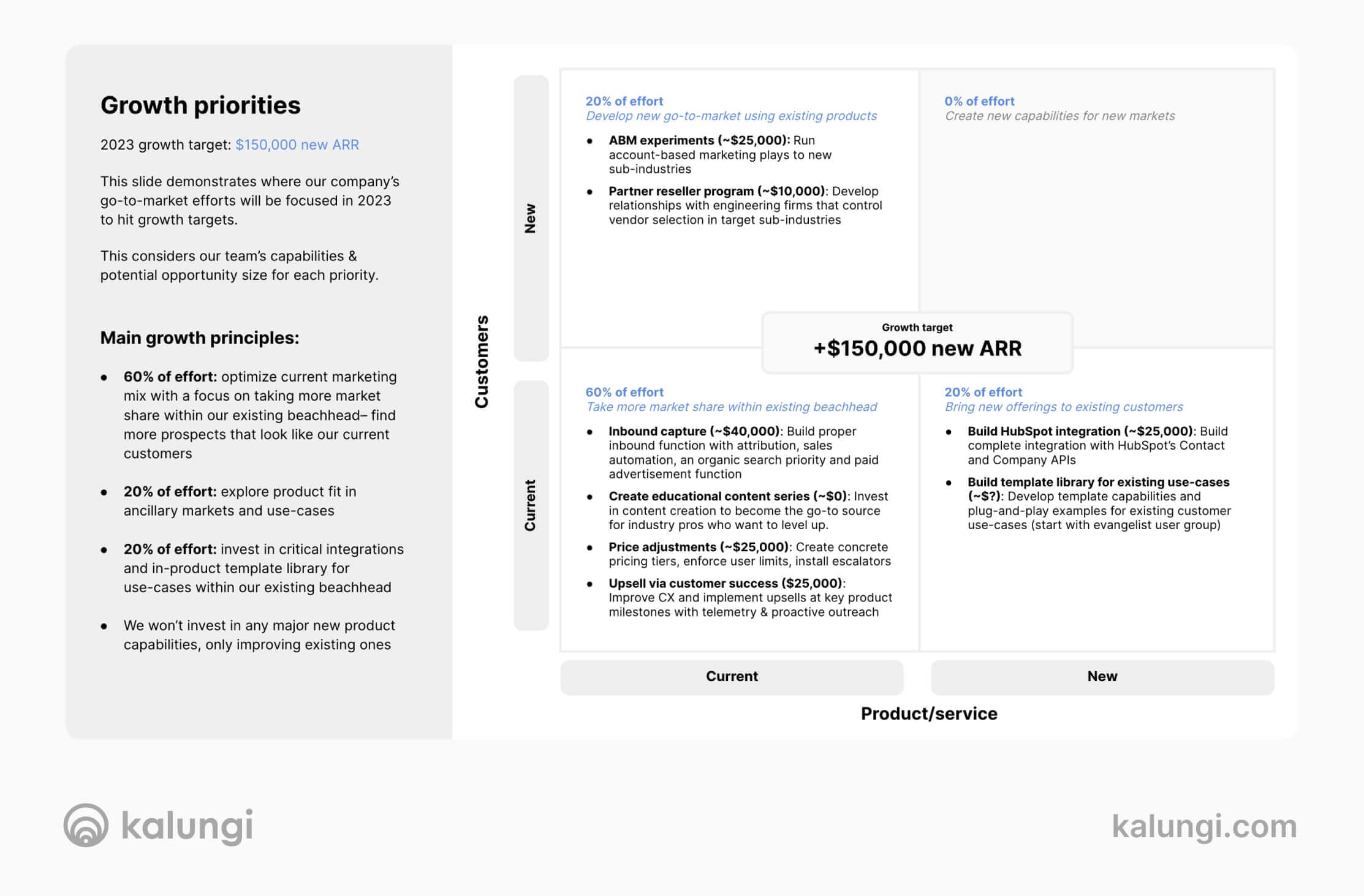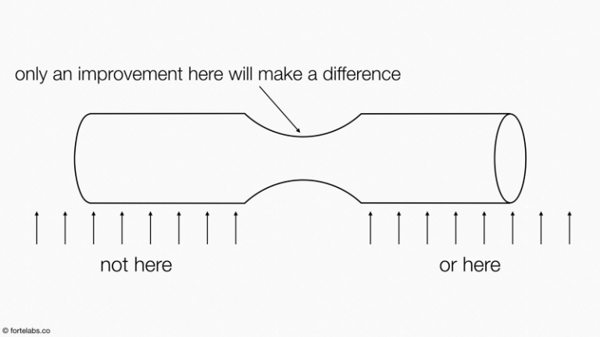Strategy Is a Team Sport. Start With Alignment
You’ve got a solid product, a growth mindset, and a plan to invest in marketing. That’s a smart move. But without a clear, aligned strategy, even the best marketing team can struggle to make an impact.
Your marketing plan must mirror the priorities of your leadership team, and guide your execution from day one.
This blog outlines Kalungi’s proven approach to aligning SaaS executives around a go-to-market strategy that works. It combines frameworks like Ansoff’s Matrix, Objectives and Key Results (OKRs), and the Theory of Constraints to help you choose the right strategy, gain buy-in, and stay focused.
1. Align Leadership Around Shared Strategic Goals
Before you choose campaigns, tactics, or tools, get your leadership team aligned on the what, why, and how of your business strategy.
Use the following questions to guide that alignment:
What are we doing?
Why are we doing it?
- What customer pain points are we addressing?
- What’s the story behind our company and mission?
- What real-world gains do our customers experience?
What are our marketing goals?
- What outcomes do we expect, pipeline, MQLs, conversions?
- What metrics define success, ROI, CAC, funnel velocity?
How are we going to achieve them?
- What campaigns and channels will we use?
- What’s the balance between inbound and outbound?
- How will sales and marketing collaborate?
Only once your team is aligned on these fundamentals should you choose the strategic growth path forward. That’s where Ansoff’s Matrix comes in.
2. Use Ansoff’s Matrix to Prioritize Strategic Growth Paths
Ansoff’s Matrix is a classic but powerful tool for visualizing your growth options based on market and product focus. It breaks growth into four paths, each with different levels of risk and required investment.
The 4 Strategic Growth Options:
It breaks down the expansion process into 4 main areas.
- Current Markets & Current Products (Low Risk): This is the “comfort zone”, focusing on market penetration in areas in which the business already operates.
- Current Markets & New Products (Medium Risk): The focus in this area of expansion is product development.
- New Markets & Current Products (Medium Risk): In this area, businesses focus on market development, reaching out to new types of customers.
- New Markets & New Products (High Risk): This is the most dramatic move businesses can make according to the matrix - venturing into both product and market expansion.
| Market |
Product |
Risk |
Strategy |
| Current |
Current |
Low |
Market Penetration |
| Current |
New |
Medium |
Product Development |
| New |
Current |
Medium |
Market Development |
| New |
New |
High |
Diversification |
Why this matters:
- Market Penetration is your short-term win. Focus on optimizing what’s working.
- Product or Market Development helps you expand without overextending.
- Diversification should be approached cautiously, it’s high risk, high potential.
Use this matrix to prioritize your strategic initiatives and align marketing with business objectives.
Kalungi clients often create a simple slide that visualizes these quadrants and use it in GTM planning sessions.

3. Translate Strategic Insights Into Focused Execution
Once you’ve identified where your growth will come from (e.g., new products, existing customers), make that vision actionable across your teams.
Steps to operationalize your strategy:
- Add your matrix slide to your GTM plan.
- Set clear OKRs based on your chosen strategy.
- Prioritize the “low-hanging fruit” (e.g., market penetration) for early wins.
- Align your marketing and sales teams around targeted efforts.
For longer-term growth strategies, like entering new markets or building new products, allocate the necessary R&D and leadership resources from the start.
Use a separate product/feature matrix to refine your messaging and positioning around the value your customers care about most.
If you'd like to create something like this for your team, check out our step-by-step guide on facilitating a growth matrix exercise.
4. Use OKRs to Keep Your Team Focused on What Matters
Choosing the right strategy is only half the battle. Execution depends on clarity, accountability, and momentum.
OKRs (Objectives and Key Results) are a proven way to:
- Align teams around shared goals.
- Break strategy into measurable milestones.
- Filter out distractions that don’t support your primary objectives.
Example:
If your focus is market penetration, your objective might be “Increase share in our current vertical,” with key results like “Grow inbound leads by 40%” or “Improve demo-to-close rate by 20%.”
OKRs help your marketing team stay grounded in the strategy—while giving leadership clear insight into progress

5. Apply the Theory of Constraints to Remove Bottlenecks
Great strategy and OKRs don’t matter if your team gets stuck. That’s where the Theory of Constraints (TOC) comes in.
TOC is a business framework focused on identifying and improving the weakest link in any system, so your team can execute faster and more efficiently.

Here’s how it works:
- Identify the current constraint.
- Exploit it using current resources.
- Subordinate all other actions to support that constraint.
- Elevate the constraint with additional investment if needed.
- Repeat the cycle, because the next weakest link will surface.
TOC is ideal for fast-moving SaaS teams that need continuous improvement without over-engineering their systems.
Use TOC alongside Lean, Agile, or OKR frameworks. Focus only on the constraints that block progress, not on fixing everything.
TOC helps you improve:
- Product development workflows.
- Marketing funnel velocity.
- Sales enablement and lead nurturing.
- Communication between teams.
Learn more in our full article on The Theory of Constraints in SaaS Marketing.
Build Strategy With Alignment, Execute With Focus
Building your SaaS marketing strategy shouldn’t feel like guesswork, or politics.
When you align your leadership team, prioritize based on risk and opportunity, and manage execution with proven frameworks, your marketing team can become a growth engine instead of a cost center.
If you are interested in learning more about the best ways to kick-off and manage your new marketing team, please take a look at some suggested readings below:
- Introduction to Ansoff’s Matrix - Facilitating a strategy journey for the executive team
- A strategy is not the perfect path, it’s a series of choices, each of which brings its own implications. - Michael Porter
- Thrash early. Prioritize. Ship - Projects always suffer when project managers lack the discipline to make important decisions as early as possible, or if they revisit them for political reasons. ShipIt-Journal download and audio
- Constraints drive efficient and profitable production. Finding scarce resources or fixing the constraining process can streamline or amplify the desired outcomes. [Eli Goldratt]
- You can work in your business or on it. [Michael Gerber]
- Strategy and tactics matter. The Art of War is about choices. Game theory is not about games. Interactive tools are here.
- Edge cases: Almost all successful startups seemed like a lame idea at first [What Microsoft Is this the Altair Basic of?] and [Stephen Johnson]
Ready to Build and Execute a Strategic Marketing Plan?
Kalungi helps B2B SaaS startups and scale-ups build high-performing marketing functions that align with business goals from day one.
We use tools like Ansoff’s Matrix, OKRs, and TOC to help your team prioritize, execute, and scale with clarity.
Book a free discovery call here.
